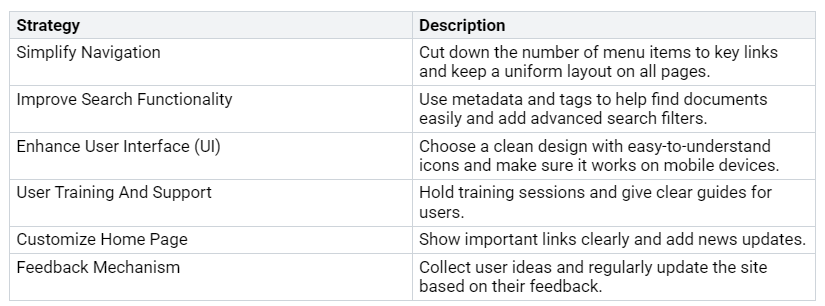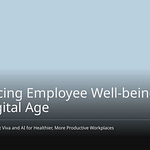Many organizations have a hard time managing their knowledge. SharePoint often turns into a place for unused files. This leads to broken knowledge areas. You might find it hard to quickly find important documents. This is because the search tools do not work well. The old user experience can make it hard to use the platform. Without a clear plan, you may have more maintenance work and harder updates. Changing SharePoint into a real Knowledge Engine can greatly improve your organization’s efficiency and teamwork.
Key Takeaways
Change SharePoint into a Knowledge Engine by organizing files and making search better.
Use clear naming rules and central storage to cut down mess and improve document handling.
Add metadata tags to make searching easier and help users find important files fast.
Set up rules and clear ownership to keep data good and build user trust in SharePoint.
Promote ongoing training and support to create a culture of constant improvement and user involvement.
The Problem with SharePoint
SharePoint often turns into a place where organizations dump files. Employees may upload documents without any order. This creates a messy space where important files get lost with unneeded ones. When you look for a specific file, it can be hard to find it because of too many old or useless documents.
The results of this problem are serious. Studies show that employees waste 2.5 hours daily looking for information. This lost time adds up, costing organizations up to $9 million a year because of bad document management. Also, 61% of executives say that poorly managed documents slow down important actions, which can hurt your organization’s overall productivity.
Old versions of documents create another problem. When there are many versions, it causes confusion. Teams might use different files, leading to mistakes and inconsistencies. Disorganized contracts can cause contractual disputes and compliance issues. In regulated fields, missing audit records can lead to fines worth millions. You may also face big hidden costs from bad version control, which wastes time and resources over time.
Also, the search feature in SharePoint often does not meet user needs. Employees often get irrelevant results and old information. A Gartner survey says that 47% of digital workers have trouble finding the information they need to do their jobs well. This problem can cause frustration and lower morale among your team. In fact, employees lose up to 9 hours per week searching for information because of poor search tools in SharePoint.
To fix these problems, you need to see how important it is to set clear naming rules and use centralized storage systems. Setting up approval workflows can also help make document management easier. By doing these things, you can change SharePoint from a messy storage place into a trusted source of truth for your organization.
Root Causes of SharePoint Misuse
Many organizations have problems with SharePoint because they lack rules and order. Without clear policies, chaos can happen. Here are some main issues that come from this lack of rules:
Unmanaged Sprawl: Without rules, your organization faces unmanaged sprawl. This makes it hard to manage workspaces well.
Compliance Challenges: Bad rules make it tough to track content. You may struggle to ensure all documents follow the rules.
Lack of Insight: Organizations often do not see what employees create. This makes it hard to enforce rules and manage documents.
Another big problem is the deep folder structures that many organizations use. These can be hard to navigate and keep up. Here’s how deep folder structures affect your experience:
User Confusion: With many folder levels, it’s hard to find what you need. This confusion can cause inefficiency and frustration.
Inefficient Navigation: A complicated structure makes it tough to find documents quickly. You may waste time going through layers of folders instead of getting information fast.
To fix these problems, think about using strategies that make navigation easier and improve user experience. For example, you can:
By fixing these root causes, you can change SharePoint from a messy storage place into a well-organized knowledge engine.
Transforming SharePoint into a Knowledge Engine
To change SharePoint into a real Knowledge Engine, you must focus on three key parts: logical navigation, metadata tagging, and lifecycle management. These parts work together to make a clear space where information is easy to find and manage.
Logical Navigation
Logical navigation makes it easier for users to find information. It helps create a clear path in your SharePoint space. Here are some benefits of good navigation:
By using logical navigation, you can greatly improve user experience and cut down the time spent looking for documents.
Metadata Tagging
Metadata tagging makes documents easier to find in SharePoint. When you tag documents with useful metadata, you make them easier to search for. Here are some important points about metadata tagging:
Metadata tagging helps users find documents better by improving searchability and user experience in SharePoint.
Consistent metadata allows better filtering of search results, leading to more relevant documents being found.
Tagging documents with useful metadata boosts their ranking in search results, prioritizing matches against metadata over document text.
Faceted navigation lets users refine search results by using multiple filters based on extra metadata.
By using a consistent method for metadata tagging, you can help users find the right information quickly and easily.
Lifecycle Management
Lifecycle management strategies help keep your SharePoint space clean and organized. Here are some effective strategies:
Inactive Site Management: Helps find and manage inactive sites. This reduces content clutter and saves on storage costs.
AI-Driven Insights: Uses AI to find high-storage and inactive sites. This gives useful insights for managing content.
Automated Policies: Sets up automated rules to handle inactive sites. This reduces clutter and improves storage use.
These strategies make sure your SharePoint stays a reliable Knowledge Engine, free from unnecessary clutter.
Importance of Governance and Clear Ownership
Governance is very important for keeping SharePoint as a trusted Knowledge Engine. Clear ownership of SharePoint sites affects content quality and user trust. Here’s why governance is important:
By setting clear ownership and governance rules, you can improve the quality and accuracy of the information in SharePoint. This creates a trustworthy space where users can rely on the information available.
Best Practices for Continuous Care
To keep a successful SharePoint environment, you need to focus on continuous care. This means more than just cleaning up once. It includes regular training and support so users feel confident and involved with the platform.
Ongoing Training and Departmental Champions
Building a culture of continuous learning is very important. You can do this by creating departmental champions who support SharePoint use. These champions help promote best practices and make sure users adopt the platform. Here’s how they help:
These champions show new behaviors and explain how insights can improve service operations. Their work leads to real support and ownership of the platform.
Shift to Continuous Management
Moving from one-time cleanups to continuous management is very important. Regular audits help keep SharePoint running well and secure. You should do these audits often to find problems early. This proactive way stops bigger issues from happening.
Also, think about these best practices for ongoing training:
Incentivizing Participation: Give rewards or recognition for user involvement.
Continuous Support and Feedback Mechanisms: Set up ways for users to ask for help and share feedback.
Leadership Buy-In and Advocacy: Get executives to support SharePoint use.
Creating User-Friendly Interfaces: Make easy-to-use designs to improve user experience.
Providing Ongoing Training and Resources: Keep users updated with continuous learning materials.
By using these strategies, you can make sure SharePoint becomes a true Knowledge Engine. This change improves document management, boosts security, and makes processes smoother, which helps your organization overall.
Changing SharePoint into a trusted source of truth can greatly improve how well your organization works. By using best practices, you can set up a central document management system. This system makes it easier to access documents and ensures they are accurate.
Here are some important points from successful changes:
Custom Intranet Portal
Workflow Automation
Enhanced Collaboration Spaces
Advanced Security Protocols
To see how well you are doing, keep track of things like knowledge contributions, how often users engage, and how fast you respond to queries. Following these steps not only makes users happier but also helps SharePoint become a key part of your daily work. Start this journey, and see your organization grow!
FAQ
What is a Knowledge Engine in SharePoint?
A Knowledge Engine in SharePoint helps organize information well. It makes it easy to find documents quickly. It also makes sure your team gets accurate data.
How can I improve SharePoint’s search functionality?
You can make search better by using metadata tagging. This way, users can filter results and find the right documents faster.
Why is governance important for SharePoint?
Governance makes sure there is clear ownership and management of content. It helps keep data quality high and builds trust among users.
How often should I conduct audits on SharePoint?
You should do audits regularly, about every six months. This helps find problems early and keeps your SharePoint space organized.
What role do departmental champions play?
Departmental champions help promote best practices and support users. They make sure everyone uses SharePoint well and feels confident with the platform.














